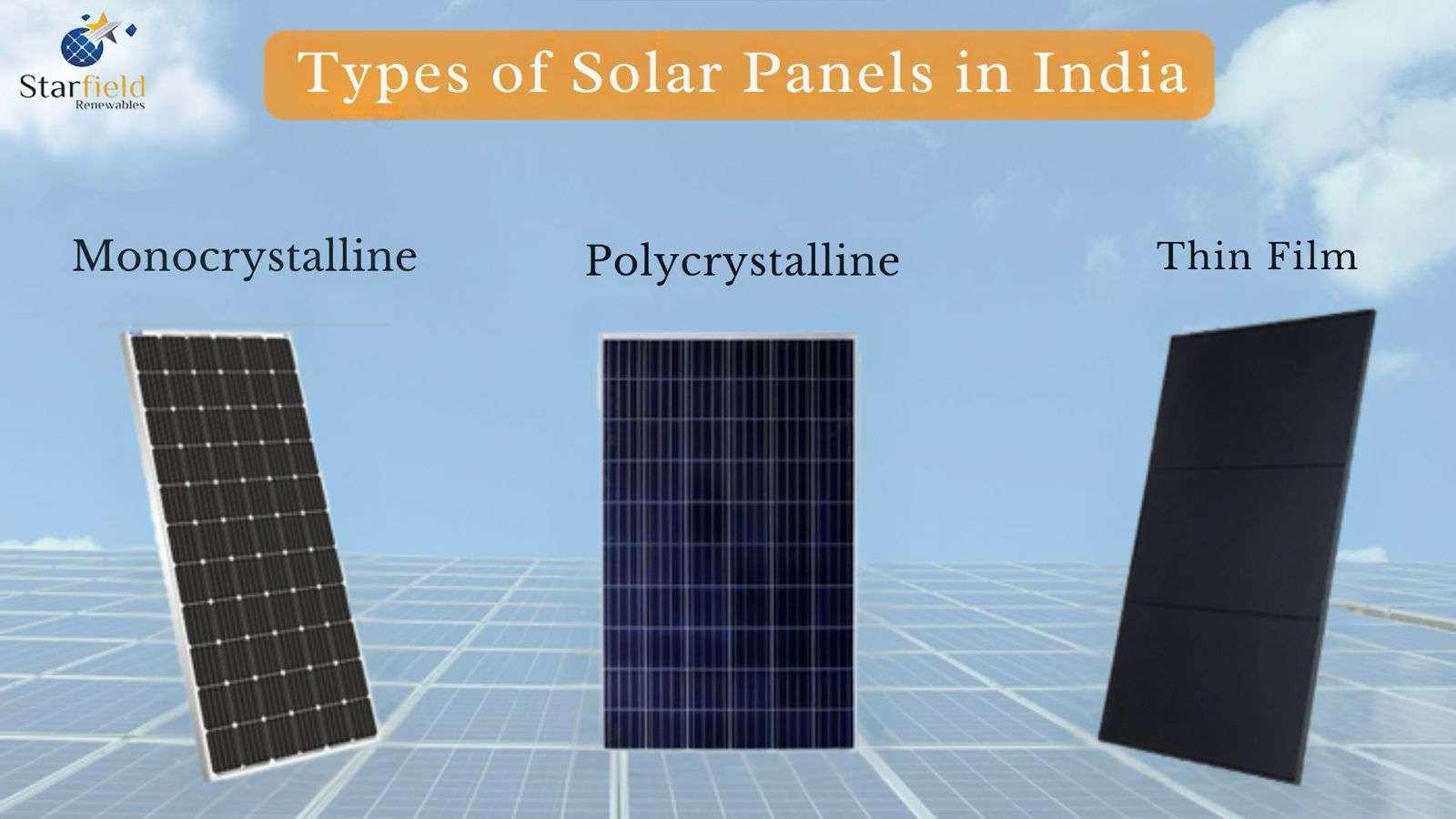India has made great strides in embracing solar power due to the abundance of sunshine in the country. Because of its vast landmass as well as its high levels of solar energy India is now the ideal location for solar energy production.
The Indian government has set high-level goals under the National Solar Mission, which aims to reach 100GW of solar power in 2022. This has also boosted growth in the solar industry which has made installing solar panels easier and affordable.
Understanding Solar Panels
Before we discuss the various types of solar panels India, we need to be aware of how solar panels function. The primary function that solar panels perform, referred to by the name of photovoltaic (PV) panels are to produce electricity by using sunlight. This process of turning sunlight into electricity happens by using photovoltaic cells that are made mostly from silicon.
Importance and Relevance of Solar Panels
If you are looking to produce electricity from sunlight, you need to utilize solar panels in line with your needs since solar panels are required for converting sunlight to electricity
Solar panels play an essential part in reducing greenhouse gases and fossil fuels as well as providing sustainable energy sources. Understanding the various types of solar panels that are available will assist you in selecting the best panel for your requirements.
“Starfield Renewables is the best solar panel company in Agra. Their solar panel dealers in Agra, and Mathura have set up many projects and you can also book solar panel systems anywhere in India from them. They will take care of all your solar panel needs and assist you at any time.”
| Types of Solar Panels | |
| 1 | Monocrystalline solar panel |
| 2 | Polycrystalline solar panels |
| 3 | Thin-film solar panels |
| 4 | Amorphous silicon panels |
| 5 | MONO PERC Modules |
Different Types of Solar Panels in India for Homes and Businesses
There are a variety that solar panels are available, each having distinctive characteristics and benefits. In India you will find four types of solar panels that differ not just in appearance and production but also in the price and effectiveness.

1 – Monocrystalline Solar panels
Monocrystalline solar panels are composed out of silicon-free crystals. They feature dark blue or black cells. They are known for their efficiency and high performance, even though they cost a greater price than other varieties. In India monocrystalline panels are the most popular option for those who live in homes or businesses that have limited space. They account for 36 percent of the market for solar panels. They are extremely efficient with conversion rates of 18-24% which makes them the best choice for commercial-scale solar power.
A significant advancement in this area is the half-cut design of cells. By cutting square-shaped cells in two, the amount of cells that are in each panel increases by. This allows the panel to keep generating power even when part or all of the panel is located in shade, leading to better performance, especially in shaded regions.

5 Key Features of Monocrystalline Solar Panels
- Efficient: Highest sunlight-to-electricity conversion.
- Powerful: Consistent energy output, even in low light.
- Durable: Long lifespan, maintains efficiency over time.
- Compact: Generates more power in less space.
- Stylish: Sleek black appearance.
2 – Polycrystalline Solar Panels
Solar panels made of polycrystalline are 2nd most widely used type of solar panel available in India. They are constructed from small pieces of quartz crystals which melt and are then transformed to form silicon slices. While they’re not as efficient in generating electric power as monocrystalline panels they’re also more affordable. Polycrystalline panels boast a 22.3 percent market share just behind monocrystalline panels. Their effectiveness for solar power technology varies from 14-16 per cent.
These panels, sometimes referred to as multi-crystalline panels, are made out of fragments composed of quartz crystals. When they are made the waste silicon is made into a mold and then cut into wafers to make solar cells. This process provides polycrystalline panels as an affordable alternative for those looking to harness solar energy while on the tightest budget.
5 Key Features of Polycrystalline Solar Panels
- Cost-effective: Lower production cost compared to monocrystalline panels.
- Durable: Long lifespan and reliable performance.
- Efficient: Good energy conversion, especially in warmer climates.
- Versatile: Suitable for various applications, both residential and commercial.
- Environmentally friendly: Less waste produced during manufacturing.
3 – Thin-film Solar Panels
In contrast to polycrystalline and monocrystalline solar panels they are produced using photovoltaic components like amorphous silicon (a-Si) as well as copper-indium gallium selenide (CIGS) and Cadmium Telluride (CdTe). These are coated on surfaces like glass, plastic or metal and make the panels light and easy to put up.
Thin-film panels are smaller than other kinds which makes them suitable for buildings in commercial use and portable solar systems like panels on boats. They do have a disadvantage in that their power capacities and efficiency are generally lower than polycrystalline or monocrystalline panels. Their efficiency ranges between 18 and 21 per cent in field and laboratory conditions. Thin-film solar panels account for around 21 percent of the market far behind polycrystalline and monocrystalline options.
5 Key Features of Thin-Film Solar Panels
- Lightweight and Flexible: Thin-film panels are lighter and more flexible than traditional panels, allowing for diverse installation options.
- Cost-Effective: Generally, they have lower production costs, making them a budget-friendly choice.
- Versatile: Suitable for various applications, including building integration and remote locations.
- Environmentally Friendly: Lower material usage and less energy-intensive production process compared to crystalline panels.
- Improved Performance in Low Light: Often exhibit better performance in low-light conditions.
4 – Amorphous Silicon Panels
Panels made of amorphous silicon are one type of solar panel widely utilized in India. These tiny silicon panels are used primarily to power lighting fixtures in outdoor homes since their light and flexible design is ideal for outdoor installations. They’re part of the first and second-generation solar cell technology.
But the amorphous silicon panels aren’t efficient enough to provide power for a whole home, or even a large part of it, since they’re about 10 per cent more inefficient than polycrystalline panels. Their efficiency is low, which allows them to be used for smaller applications, such as lighting for outdoor areas rather than for full-scale home power generation.
5 Key Features of Amorphous Silicon Panels
- Low-light Performance: Excel in converting sunlight, even in cloudy or low-light conditions.
- Flexible and Lightweight: Can be applied to various surfaces due to their thin and flexible nature.
- Rapid Manufacturing: Faster production process compared to crystalline panels.
- Indoor Applications: Can generate electricity from indoor light sources.
- Cost-Effective: Generally lower production costs compared to crystalline counterparts.
5 – MONO PERC Modules || Solar panels
Mono PERC (passivated emitter and rear cell) technology is a major technological advancement in the efficiency of solar panels and performance. It is a more efficient version of monocrystalline modules Mono PERC panels have an added layer that is attached to the back of the solar cells.
Passivation of the rear cell on mono PERC panels enhances light absorption and also reduces electron recombination. This results in greater energy output and better performance, especially in dim conditions. This breakthrough not only boosts the efficiency of solar panels, but additionally makes them more cost effective through the maximum utilization of the sunlight that is available.
5 Key Features of Mono PERC Solar Panels
- High Efficiency: Mono PERC technology significantly improves light absorption, resulting in higher energy output compared to standard monocrystalline panels.
- Improved Low-Light Performance: Enhanced efficiency in low-light conditions due to better light capture.
- Better Temperature Coefficient: Less power loss in hot weather, maintaining consistent performance.
- Increased Durability: Improved resistance to degradation, ensuring a longer lifespan and reliable operation.
- Cost-Effective: While initially premium-priced, the technology has become more affordable, offering a good balance of efficiency and cost.
Conclusion: Types of Solar panels
The majority of people advise to install any kind that solar power system in India. Once you have gathered all the data, it becomes easy to choose. Always consider the benefits and drawbacks of each choice when selecting the ideal energy source for the home. Choose reputable companies like Starfield Renewables is the best solar panel manufacturer in India to enjoy a sustainable alternative to energy.
FQAS About Solar Panel Types In India
1 – How many types of solar panels are mainly available in India?
The most popular types of solar panels in India are polycrystalline, mono PERC, half-cut, and bifacial solar panels.
2 – Who is the best solar palace dealer in Agra?
Although there are many solar panel dealers in Agra, but if you want to get high-quality solar panels installed at a low cost, then you can contact Starfield Renewables company because Starfield Renewables is the best solar panel company in Agra.

